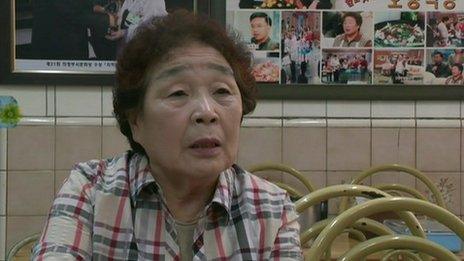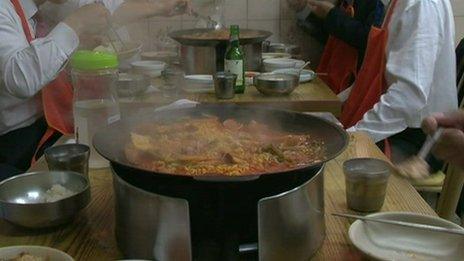Why is Spam a luxury food in South Korea?
- Published
A look at why Spam is so popular in South Korea
Asia is celebrating the annual lunar thanksgiving holiday this week. In South Korea, where it's known as Chuseok, the holiday is celebrated by visiting family, paying respects to ancestors... and the giving and receiving of packaged cans of Spam.
The pre-cooked tins of pork meat are the stuff of jokes, lunch boxes, wartime memories and, here in South Korea, a low-key, national love affair.
Spam has become a staple of South Korean life, and the country is now the biggest consumer of it outside the US.
Since Spam was first launched in the US before World War II, more than seven billion of these chunky little cans have rolled off production lines - like the ones at Spam's South Korean factory in Chuncheong Province.
Here you can find Classic Spam, Mild Spam, Bacon Spam, Garlic Spam…. "If you've got Spam" the slogan on the can proclaims, "you've got it all!"
So, not for South Korean cans, a dusty shelf at the back of the supermarket.
Humble origins
Spam, and its home-grown competitors, are prime gifts for the lunar thanksgiving holiday, and they are displayed with verve, in lavish gift-boxes, sometimes topped with ribbon.

Spam is considered a luxury item, although its origins are humble
The premium Black Label hamper will set you back around $75 (£50).
"It has Andalucia Olive Oil, and nine tins of Spam," the company's brand manager, Shin Hyo Eun, explains.
"Spam has a premium image in Korea. It's probably the most desirable gift one could receive, and to help create the high-class image, we use famous actors in our commercials.
"Anyone who gets a Spam gift-set also gets a warm feeling in their heart."
Spam does have a different image here, compared with the West. Where else would television commercials show a young couple ditching their romantic dinner to head home for a plate of Spam?
But its origins here are much more humble.
Smuggled spam
Spam was introduced to Korea by the US army during the Korean War, when food was scarce - and meat even scarcer. Back then, people used whatever they could find to make a meal.

Mrs Ho says she made stew from Spam smuggled from the local army base
But the appeal of Spam lasted through the years of plenty and it's now so much a part of South Korean food culture, that it's the staple ingredient in one of the country's favourite dishes: budae jigae or army stew.
There are lots of restaurants specialising in it, but the most famous line one particular street, just around the corner from a US military base.
One of the restaurants there is run by Ho Gi-suk.
She claims to have invented Army Stew back in 1954, when someone brought her smuggled spam, sausages and bacon from the local army base. Mrs Ho made them into a spicy soup, and the rest is history.
"Back then," she tells me, "there wasn't a lot to eat. But I acquired some ham and sausages… the only way to get meat in those days was to smuggle it from the army base.
"We had to make do with whatever the soldiers had left over; sometimes it was turkey, sometimes Spam. We'd make a stew with whatever came out, and my recipe was copied and spread throughout Korea."
Army Stew is now well-established as part of South Korea's culinary landscape - as traditional here as Spam gift-sets for thanksgiving.
"It's salty, and greasy, and goes very well with the spices," one customer told me. "Korean soup and American ham - it's the perfect fusion food."

The popular stew is a legacy of the US presence in South Korea during the Korean War
- Published11 September 2013
- Published26 December 2010